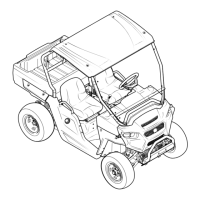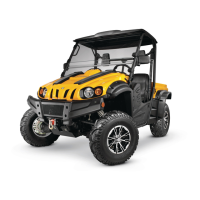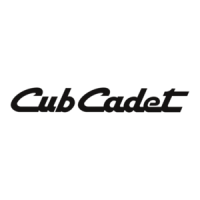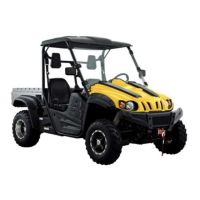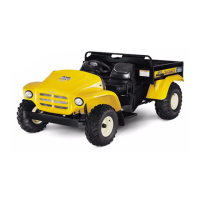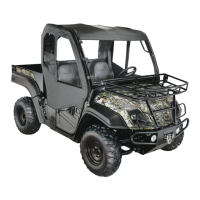4 Section 2 — Safe operation practiceS
d. Never attach ropes, chains or cables to
the OPS for pulling purposes.
e. Although the OPS, when used with a
properly secured seat belt, provides a
crush-protective environment in the
event of a tip-over or rollover, never
take unnecessary risks.
Children
1. Tragic accidents can occur if the operator is
not alert to the presence of children. Children
are often attracted to the vehicle. They do not
understand the dangers. Never assume that
children will remain where you last saw them.
Avoid run over accidents.
a. Keep children out of the immediate
area of the vehicle and in watchful
care of a responsible adult other than
the operator.
b. Be alert and turn the vehicle off if a
child enters the area.
c. Before and while backing, look behind
and down for small children.
d. Never carry small children, they may
fall off and be seriously injured or
interfere with safe vehicle operation.
e. Use extreme care while approaching
blind corners, doorways, shrubs, trees
or other objects that may block your
vision of a child who may run into the
path of the vehicle.
f. Remove key when vehicle is unattended
to prevent unauthorized operation.
2. Never allow children under 16 years old to
operate this vehicle. Children 16 years old
and over should read and understand the
operation instructions and safety rules in this
manual, should be trained and supervised
by a parent and have obtained a state-issued
motor vehicle driver’s license.
3. Do not let children ride in the cargo bed, in the
driver’s or passenger’s lap or anywhere other
than the passenger seat. Never give small
children a ride; not even in the passenger seat.
The passenger seat belts, handholds and seat
height are not designed to accommodate the
safe transport of small children.
Service
Safe Handling Of Fuel:
1. To avoid personal injury or property damage,
use extreme care in handling fuel. Fuel is
extremely flammable and the vapors are
explosive. Serious personal injury can occur
when fuel is spilled on yourself or your clothes
which can ignite. Wash your skin and change
clothes immediately.
a. Use only an approved fuel container.
b. Never fill containers in the cargo bed
inside a vehicle or on a truck or trailer
bed with a plastic liner. Always place
containers on the ground away from
your vehicle before filling.
c. When practical, remove gas-powered
equipment from the truck or trailer
and refuel it on the ground. If this
is not possible, then refuel such
equipment on a trailer with a portable
container, rather than from a fuel
dispenser nozzle.
d. Keep the nozzle in contact with the
rim of the fuel tank or container
opening at all times until fueling is
complete. Do not use a nozzle lock-
open device.
e. Extinguish all cigarettes, cigars, pipes
and other sources of ignition.
f. Never fuel vehicle indoors.
g. Never remove gas cap or add fuel
while the engine is hot or running.
Allow engine to cool at least 5 minutes
before refueling.
h. Never over fill fuel tank. Fill tank to no
more than ½ inch below bottom of filler
neck to allow space for fuel expansion.
i. Replace fuel cap and tighten securely.
j. If fuel is spilled, wipe it off the
equipment. Push vehicle away from
spilled fuel. Wait 5 minutes before
starting the engine.
k. To reduce fire hazards, keep engine
compartment and exhaust system free
of grass, leaves or other debris build-
up. Clean up oil or fuel spillage and
remove any fuel soaked debris.
l. Never store the vehicle or fuel
container inside where there is an
open flame, spark or pilot light as on
a water heater, space heater, furnace,
clothes dryer or other gas appliances.
m. Avoid injury from explosion or fire.
DO NOT carry fuel or other flammable
liquids in vehicle or cargo bed.
General Service
1. Never run an engine indoors or in a poorly
ventilated area. Engine exhaust contains
carbon monoxide, an odorless and deadly gas.
2. Before cleaning, repairing or inspecting,
make certain all moving parts have stopped.
Remove the ignition key to prevent
unintended starting.
3. Check brake and parking brake operation
frequently as it is subjected to wear during
normal operation. Adjust and service as
required.
4. Keep all nuts, bolts and screws tight to be sure
the equipment is in safe working condition.
5. Never tamper with the safety interlock system
or other safety devices. Check their proper
operation regularly.
6. Never attempt to make adjustments or repairs
to the machine while the engine is running.
7. Do not change the engine governor settings
or over-speed the engine. The governor
controls the maximum safe operating speed
of the engine.
8. Maintain or replace safety and instruction
labels, as necessary.
9. According to the Consumer Products
Safety Commission (CPSC) and the U.S.
Environmental Protection Agency (EPA), units
in this product category have an Average
Useful Life of seven (7) years, or approximately
400 hours of operation. To extend the life of
your unit, and specifically after (7) years of
ownership or at 400 hours of operation, have
the unit inspected annually by an authorized
service dealer to ensure that all mechanical
and safety systems are working properly
and not worn excessively. Failure to do so
can result in accidents, injuries or death.
See Section 4 of this Operators Manual for
Maintenance and Service schedules.
10. Observe proper disposal laws and regulations
for gas, oil, etc. to protect the environment.
11. Prior to disposal, determine the proper
method to dispose of waste from your local
Environmental Protection Agency. Recycling
centers are established to properly dispose of
materials in an environmentally safe fashion.
12. Use proper containers when draining fluids.
Do not use food or beverage containers that
may mislead someone into drinking from
them. Properly dispose of the containers
immediately following the draining of fluids.
Do Not:
1. Do not travel near drop-offs, ditches or
embankments. The vehicle could suddenly
turn over if a wheel goes over the edge of a
cliff, ditch or if an edge caves in.
2. Do not stop or start suddenly when going
uphill or downhill. Be especially cautious
when changing direction on slopes.
3. Do not turn sideways to the hill. The vehicle
may roll over. If you must turn, go slow and do
so carefully and gradually.
4. Do not carry cargo or tow loads on steep slopes.
Towing
1. Always use an approved hitch and hitch point
provided on the utility vehicle.
2. Do not tow more than 500 lbs. rolling weight
(i.e. trailer plus cargo).
3. Never load more than 85 lbs. tongue weight
on tow bracket provided.
4. Go slow and use extra care when towing a
trailer. Allow for increased braking distance.
Load trailer properly.
5. Do not tow heavy loads on slopes greater
than 5° incline. When going downhill or
turning, the extra weight tends to push the
tow vehicle and may cause you to lose control
(i.e. braking and steering ability are reduced,
towed equipment may jack-knife and cause
utility vehicle to overturn).
Cargo Bed Loading/ Operation
1. Do not exceed vehicle’s Total Payload
Capacity rating of 850 lbs. This includes
operator, passenger, accessories,
attachments, tongue weight and cargo.
2. Do not exceed 350 lbs. load in cargo bed.
3. Spread load evenly and secure to prevent
movement.
4. Do not load above height of cargo bed.
Load could shift forward and injure driver or
passenger.
5. Avoid loads which exceed the physical
dimensions of cargo bed.
6. Go slow. Heavy loads will affect steering,
braking, stability and overall handling of
the vehicle. Limit loads to those that can be
safely controlled.
7. Avoid sudden starts, stops and turns which
could cause load to shift.
Cargo Bed Lift
1. Stop vehicle on level ground and set Parking
Brake before raising cargo bed.
2. Empty heavy cargo by hand.
3. Do not operate vehicle with cargo bed in
raised position.
4. Do not operate vehicle with cargo bed
unlatched. Always latch upon manually
lowering cargo bed.
Safety Frame (OPS)
1. Your vehicle is equipped with an operator
protective structure (OPS) which must be
maintained in a fully functional condition.
Use care when driving through doorways or
spaces with a low overhead.
a. Never modify the OPS in any way.
b. Never attempt to straighten or reweld
any part of the main frame if damaged.
Doing so may weaken the structure
and endanger your safety. Replace a
damaged OPS immediately.
c. Never secure any parts other than Cub
Cadet approved accessories on the
main frame or attach the safety frame
with anything other than the special
fasteners specified.
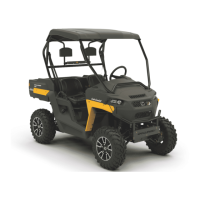
